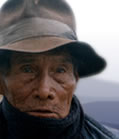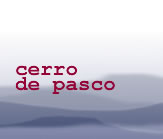THEMES IN THIS
TESTIMONY
Agriculture

Community Activities

Compensation

Conflict

Culture and Customs

Development

Economics

History

Identity

Justice and crime

Livestock

Migration

Politics

Social Change

Traditional Skills

Click on arrows
to find more
testimonies
featuring
these themes
|
|
Sex
|
male
|
|
|
Age
|
51
|
|
|
Occupation
|
campesino leader
|
|
|
Location
|
Pamparca
|
|
|
Date
|
1995
|
|
summary
Native of Pamparca, León left the community when he was 14 to escape the poverty his parents had suffered all their lives, knowing one day he would return with new ideas.
In the 12 years he was away (and during a three-year stretch later on) he missed the community, its history and customs. He blames the decline of their traditional language, trades and festivals on the unchecked expansion of the mines. Years of exploitation, migration, pollution and little compensation have taken their toll on the surrounding communities. Of 500 Pampalquinas families, only 70 are left - the majority have settled in Lima and forgotten about what happens back home. He points to the irony that, “Despite all the wealth we have here, the wealth they’re extracting from the Cobriza [mine] which we don’t get any of,… [these young people still] got to Lima, to struggle in the slums, to suffer hunger and all the rest of it.”
He talks realistically of the divisions which exist within the community - between the more wealthy campesinos and those not so well off - and between the urban and rural poor. He went to Lima to educate himself so he could contribute more fully to his community. He comments on how any campesinos who "make it" in Lima are thought to be thieves. He marries and returns home.
On his return he noticed many changes: loss of solidarity between comuneros, growing importance of the cash economy, breakdown in traditional values, general disintegration of community, although some of the old traditions remain.
León gives a vivid description of the Easter celebrations and how they have survived - but adapted - over generations. He also talks about resettling the village: it currently exists on the side of a hill and is very vulnerable to earthquakes. As president, he’s pioneered a scheme to have land 7 kilometres away irrigated and made safe for them to relocate. They’re waiting on an inspection but he believes many of the economic problems will be helped when (and if) such a move occurs. He ends with his views on the fight against pollution, organisational problems within the community and the decline of community values and the Quechua language.
detailed breakdown
|
You will need a password from Panos to view the full
transcript of the interview. To apply for a password, click here.
Once you have a password, click here to go to the beginning
of the transcript. You can also click on any section of the
breakdown of content below and go straight to the
corresponding part of the transcript.
|
| Section 1 |
History and geography of Pamparca – growth of mining territories over the past 30 years. Arrival of family in Pamparca.
|
| Section 1-2 |
Poverty of family and impact on León – desire to be instrumental in community’s development - migration to Lima.
|
| Section 2 |
He returned to the community when he was 38 married with children.
Earlier spoke Quechua and made things from local wool, now buy things from the cities.
|
| Section 2-3 |
Description of mining operations in the area and negative effects on countryside and community economy.
|
| Section 3 |
Want compensation for this damage.
Says 70% of young people prefer to leave for the cities; one result is less solidarity in the community. How the mining company has deceived the villagers, not keeping promises and only benefiting those who work for them.
|
| Section 4 |
Decline of agriculture - “the only thing produced now is copper by Centromin.”
Migration “The communities are becoming quite frankly just full of old people”. Migrants turn their back on community; only a few think about development “back home”
|
| Section 4-5 |
Decline of cultural wealth and traditional skills, materials etc - introduction of foreign music, synthetic fibres, plastics etc.
Lack of government support for example, training in rearing livestock Personal reasons for going to Lima; family background; marriage;
|
| Section 6 |
Main responsibilities of a comunero (registered community member with rights and responsibilities): to be involved in cooperative production.
Inequality between peasant farmers in terms of wealth and authority. History of problems his family have had being poor in the community.
|
| Section 7 |
His time in Lima - family, work, ideals. Problems encountered as a peasant boy – people instantly assumed he was a thief, rather than honestly working painting houses.
|
| Section 8 |
On return noticed changes to community - loss of solidarity, growing importance of money, respect for those with money (i.e. salaried workers in the mines), loss of identity.
|
| Section 8-9 |
Changing size and structure of communities as a result of migration.
|
| Section 9-10 |
Customs: traditional role of village authorities (baraya).
Easter celebrations – traditions and customs
|
| Section 10-11 |
Custom of the single men and women and the pumpkin!
Importance of handing on traditions, bit more on Easter activities
|
| Section 11-12 |
Details of children living in Huancayo studying various professions: medicine, accountancy. One is studying mining engineering and León hopes he’ll use it to one day open community-run mines. Children return to the community in the holidays but otherwise are better where they are
|
| Section 12 |
Future of community - talks about moving the village 7 kilometres a way; possibilities which will result from the irrigation scheme.
|
| Section 13 |
Need for specialist help - engineers to teach people how to work irrigation channels, produce natural fertilisers etc. Talks of other possibilities for development. Pollution: his views on how to fight it: demand levy from Centromin for damage done to land; insist on pollution control projects; get Centromin to clean up the waste.
|
| Section 14-15 |
Talks of the time when he was suspected of terrorism - activities of Sendero have quietened down.
Desire to retain the Quechua language - its important place in the cultural make-up.
Organisational problems, conflict between villages - he blames the arrival of the Cobriza mine for the decline of his community.
|
|


